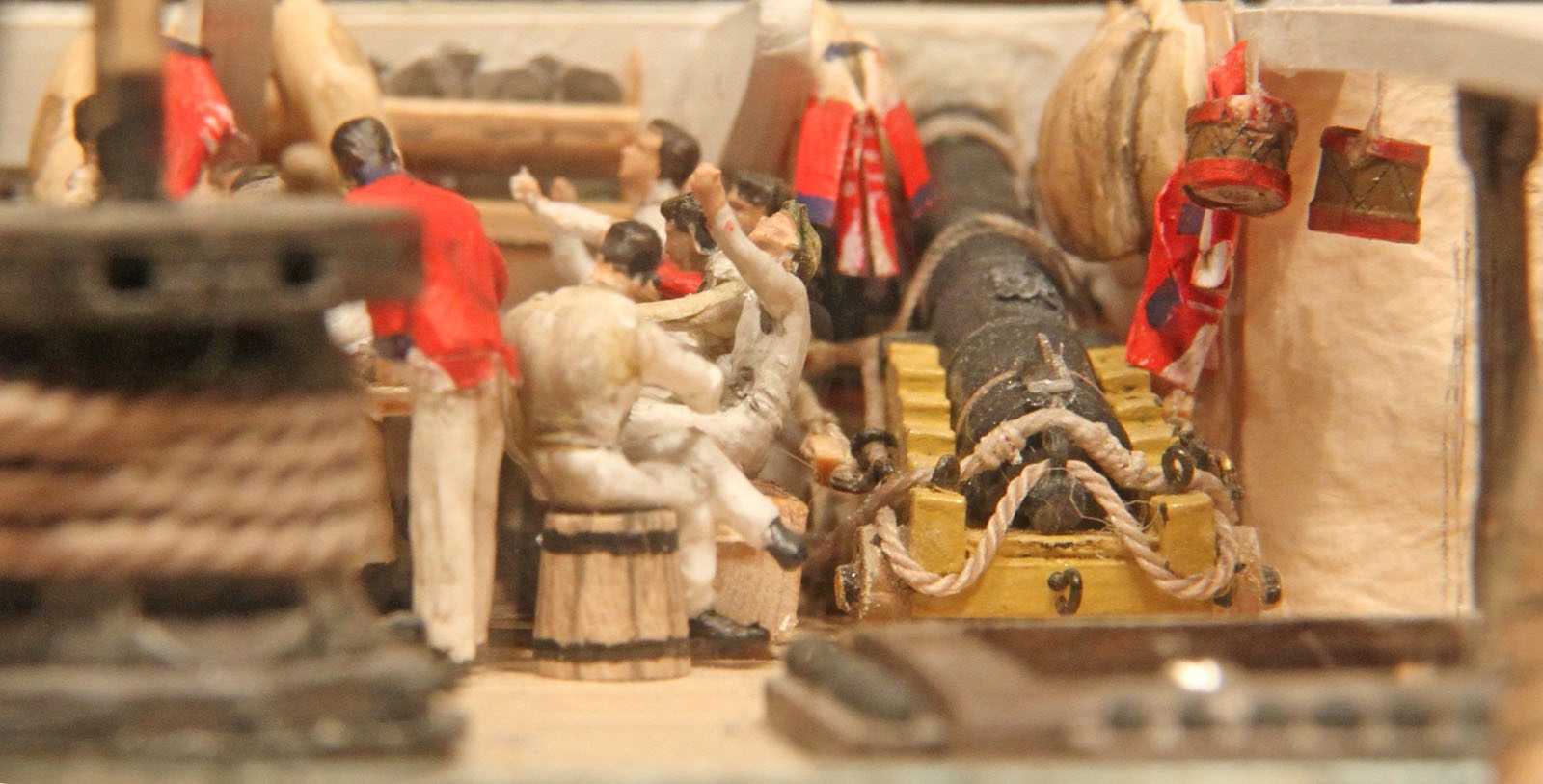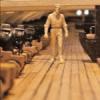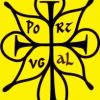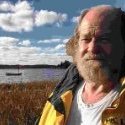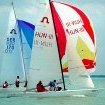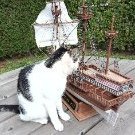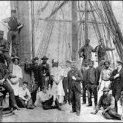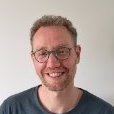HOLIDAY DONATION DRIVE - SUPPORT MSW - DO YOUR PART TO KEEP THIS GREAT FORUM GOING! (Only 64 donations so far out of 49,000 members - C'mon guys!)
×
-
Posts
2,426 -
Joined
-
Last visited
Reputation Activity
-
 dafi got a reaction from Hubac's Historian in HMS Victory by dafi - Heller - PLASTIC - To Victory and beyond ...
dafi got a reaction from Hubac's Historian in HMS Victory by dafi - Heller - PLASTIC - To Victory and beyond ...
Time to continue with the big launch.
The masts have been redesigned, with details taken from Steel.
I keep noticing that thin printed parts such as oars and masts warp after painting. See the upper half of the picture.
After a quick dip in hot water, they are straight again, see bottom half http://www.shipmodels.info/mws_forum/images/smilies/icon_smile.gif I simplified the rigging of the launch and combined various sources. As with the Hermione boats, the eye bolts were no longer attached to the top of the gunwale but underneath on the frames. It looks much clearer. Here is the first dummy rig with the newly positioned attachment points.
Once rigged, it looks like this. I actually wanted to work without stays, but due to the stubborn rigging, this is hardly possible without curvature. The mainstay should then of course lead to the foot of the foremast.
Here are the attachment points in detail. The running end is wrapped around a cleat, but not yet stowed.
And the sails are also waiting to be processed http://www.shipmodels.info/mws_forum/images/smilies/icon_smile.gif
XXXDAn
-
 dafi got a reaction from rybakov in HMS Victory by dafi - Heller - PLASTIC - To Victory and beyond ...
dafi got a reaction from rybakov in HMS Victory by dafi - Heller - PLASTIC - To Victory and beyond ...
In the meantime I was working a bit on the big guns, here are some samples.
More on that adventure here :
-
 dafi got a reaction from Hubac's Historian in HMS Victory by dafi - Heller - PLASTIC - To Victory and beyond ...
dafi got a reaction from Hubac's Historian in HMS Victory by dafi - Heller - PLASTIC - To Victory and beyond ...
And we continued with the lugger-rigged version of the large launch.
First came the masts. I took the measurements from W. E. May's summary, but they also correspond fairly closely to the French measurements. The strength of the lugger rig is its simplicity. Insert the pre-rigged mast, hook in the pairs of backstays on both sides with the standing end, hook the tackles in the middle, and belay the free end. The halyard of the sail is already sheared through in the masthead, so the sail is immediately hoisted, the tack, sheet and brail are secured, and off you go.
In my scrap box, I charmingly found a sample from my sandwich sail tests from 2017 – yes, I actually keep such things for that long – and the sizes I need fit quite well, even avoiding the messy areas. I developed the material back then to combine the advantages of fabric as an elastic material and paper for a more true-to-scale surface. Thin strips of restoration repair paper are ironed onto both sides of a layer of silk to create a sandwich that resembles closely the visual properties of the sails. It is also unbeatable for folding and stowing. However, at the time, I did not yet have a model that was ready for me to use it on ...
I took the angles from Steel's drawings, but I had to mark the radius at the bottom – one of the differences to French sails – with a pen and thread, as the radius is larger than my templates.
I shortened the furled sails by approx. 25%, i.e. below the lower reefing band, which I had also omitted for this purpose.
The surrounding leech was glued on and the eyes for the brails were added.
If necessary, I'll even clamp a sail in a vice 😉
And then it was time to fold and fiddle around.
And then it was adjusted to fit the storage space.
Together with the masts in place looks quite cheerful and full. Two barrels have also found their way there. Who can find them?
It's great to finally be able to use the sails developed eight years ago in a model myself. Some modeling friends have already impressively demonstrated their potential. Thank them for that.
And I'm already testing out the next crazy ideas for my boat collection...
XXXDAn
-
 dafi got a reaction from rybakov in HMS Victory by dafi - Heller - PLASTIC - To Victory and beyond ...
dafi got a reaction from rybakov in HMS Victory by dafi - Heller - PLASTIC - To Victory and beyond ...
At the same time, work continued on the boats, especially on the 32-foot launch.
The nice thing about printing is that you can simply repeat, so suddenly there were 4 hulls in front of me. What am I supposed to do with them again?
The little devilish voice inside me then came immediately: Build it! Build it!
Well, that's the way it happened.
Here are the 4 steps of the interior: Priming black to prevent flashes, dark brown for the inner body, thin black ink for depth and usage, and white drybrush to bring out the textures again.
On the other hand, I painted the interior parts with a lighter shade of brown, inked and brushed them to emphasise them a little. It could also have been interpreted as different wood.
But when I looked at it ...
... and compared it with the first launch at the front in a completely lighter colour ...
... it looked too much like a toy to me, and the dafi had to do what it does best - tear it down! - and everything flew out again ...
... and the inside of the boats has been coloured lighter. Fits much better now http://www.shipmodels.info/mws_forum/images/smilies/icon_smile.gif
Here is a picture showing how the barrels fit - that's easily over 7 tonnes of weight -, in the middle the rowing version, and the third one still without thwarts , where you can see the height of the stretchers above the inner floor. Then you can also see that the rowers' feet would otherwise have been hanging in the air and intensive pulling would not have been so successful.
So that I don't always get the thwarts mixed up, I have given them markings on the underside. The stretchers too, by the way.
XXXDAn
-
 dafi got a reaction from rybakov in HMS Victory by dafi - Heller - PLASTIC - To Victory and beyond ...
dafi got a reaction from rybakov in HMS Victory by dafi - Heller - PLASTIC - To Victory and beyond ...
And once again I've made a mistake. This drawing from 1815 shows the loading of the large launch with barrels of drinking water.
And so, of course, I had to know how big the barrels were in order to put them in my launch. These large barrels are so-called Leaguers with the equivalent of 480 liters. So with wood, they weigh over half a ton. And then 14 of them in the boat, making well over 7 tons.
The research was somewhat difficult, as the volumes are often mentioned, but not the exact dimensions. In the meantime, I have researched the sizes of the whole family more or less reliably, so that I was able to start on the models.
Here are the 3 sizes for the model: Leaguer 480 liters, Puncheon 318 liters, Hogshead 200 liters and a small powder keg. Each in three parts, as I don't want the supports to be visible as usual.
Family picture with avatar.
And after priming and inking came the challenge: blackening the hoops.
At the back right was with the brush. On a good day, I get a few hoops, but then it's all over. Okay, that wasn't a particularly good day anyway. So I tried the back left with a felt-tip pen, which was better, but still uneven and above all an unpleasant metallic-reddish sheen.
And in front a completely different approach, because I remembered that the prints are made of black resin. I quickly tried to see if sanding the hoops worked, and lo and behold ...
... it works like a charm!
The powder keg was given its copper hoops and light-colored withy rings and joined the others. No iron hoops on purpose, because they could cause sparks and that would be really stupid. The copper is also nicely embedded between the withy rings so that it doesn't stick out. There are wonderful artifacts showing this, recovered from the HMS Invincible, which sank in 1758.
And that brings us very close to what I wanted 🙂
XXXDAn
-
 dafi got a reaction from rybakov in HMS Victory by dafi - Heller - PLASTIC - To Victory and beyond ...
dafi got a reaction from rybakov in HMS Victory by dafi - Heller - PLASTIC - To Victory and beyond ...
I had finally found the time to finish off a few little things around the stove. It was slowly becoming what I wanted http://www.shipmodels.info/mws_forum/images/smilies/icon_smile.gif
Here are two colour versions, one with a classic red brick floor and one with the typical southern English yellow-beige floor covering.
And here in the detail shots you can also see the warming trays that could be hung on the handrail of the cooker.
Of course, the stove also includes the kitchen area. I have chosen the wickerwork that can be seen on the contemporary model of the Princess Royal and others.
The whole thing is a cute little kit of 22 parts. The drive chain is twisted copper wire and the rail is bent wire, for which there is a template.
Here are a few more details:
The base plate with catch tray and tube for the fresh air supply from the deck below ...
... the stove body ...
... the holders for the skewers ...
... the distiller with all its attachments ...
... ... and the cowl, all that's missing is the round cover plate against rain and storm.
As usual, the ensemble was finished with a little diluted ink and a white drybrush, and the metal parts with a little graphite.
XXXDAn
PS: And it took me a while before I had the courage to print the warming trays directly and completely. But all the attempts to glue the holders on with holders were just horrible in the result ...
-
 dafi got a reaction from rybakov in HMS Victory by dafi - Heller - PLASTIC - To Victory and beyond ...
dafi got a reaction from rybakov in HMS Victory by dafi - Heller - PLASTIC - To Victory and beyond ...
Waiting for Godot ...
Since the geometry of the boats is highly complex, the printer has to run at the highest resolution, and that takes time ...
That's why I used the time in between to finish a few other things, or rather to give them a final polish.
All the bitts on the upper deck have now been joined by the bitts on the upper battery deck, which hold all the halyards of the main mast. Big strong things with nice rollers in the base.
Here with the swifel pump in between.
You can already admire them in the open heart of my Vic.
The matching deck beam supports. Cheaper by the dozen. A bit of drybrushing here too to modulate the shape.
Plus the small kit of the riding bitts and what you can be done with it.
And I would like to take this opportunity to out myself again: As much as I like and need high-quality tools, but often nothing beats the basics!
- A sheet of sandpaper on the table and you can make smooth and even strokes when sanding
- Sandpaper stuck to wooden sticks using double-sided tape allows sanding tools to be cut to the exact width of the workpiece using the width of the sticks. Some of the sticks shown here are exactly the width of the gunports of my Constitution.
- Right-angled blocks facilitate sanding at a 90° angle.
And when the paper is blunt, a new one is put on.
And here is the guessing game of what else I have prepared 😉
Best regards, Daniel
-
 dafi got a reaction from rybakov in HMS Victory by dafi - Heller - PLASTIC - To Victory and beyond ...
dafi got a reaction from rybakov in HMS Victory by dafi - Heller - PLASTIC - To Victory and beyond ...
Time to continue with the big launch.
The masts have been redesigned, with details taken from Steel.
I keep noticing that thin printed parts such as oars and masts warp after painting. See the upper half of the picture.
After a quick dip in hot water, they are straight again, see bottom half http://www.shipmodels.info/mws_forum/images/smilies/icon_smile.gif I simplified the rigging of the launch and combined various sources. As with the Hermione boats, the eye bolts were no longer attached to the top of the gunwale but underneath on the frames. It looks much clearer. Here is the first dummy rig with the newly positioned attachment points.
Once rigged, it looks like this. I actually wanted to work without stays, but due to the stubborn rigging, this is hardly possible without curvature. The mainstay should then of course lead to the foot of the foremast.
Here are the attachment points in detail. The running end is wrapped around a cleat, but not yet stowed.
And the sails are also waiting to be processed http://www.shipmodels.info/mws_forum/images/smilies/icon_smile.gif
XXXDAn
-
 dafi reacted to rwiederrich in Footropes, Flemish Horses and Stirrups
dafi reacted to rwiederrich in Footropes, Flemish Horses and Stirrups
I’ve always reminded builders to keep their stirrups/foot ropes very short. I made sure they were on my Glory of the Seas. The men working the sails are able to do so.
Rob
-
 dafi got a reaction from Kenchington in Footropes, Flemish Horses and Stirrups
dafi got a reaction from Kenchington in Footropes, Flemish Horses and Stirrups
I had once an analysis to the "3 feet below the yard". It is measured from the top of the yard in my opinion, other points of taking the measure do make no sense imho.
Short Executive Version:
The simplyfied definition "3 feet underneath the yard" would possibly read on the working basis like this:
Stirrup 3 Feet long, with enough overlength to do 3 turns around the yard and nailed to the top of the yard. Hangs behind and underneath the yard.
XXXDAn
-
 dafi reacted to Vane in Chris Watton and Vanguard Models news and updates Volume 2
dafi reacted to Vane in Chris Watton and Vanguard Models news and updates Volume 2
We shouldnt judge a 20 year old project too harsh. During the 90s, Caldercraft pushed the bounderies much and was one of the few companies that actually developed new kits. However, its a pity that most old classic manufactureers of shipmodels live on very old kits and have completely stopped making new kits. That is why we all also appreciate and follow Chris and Vanguard models. 20 new kits in just a few years and constantly new designs and solutions. Many was quite disappointed when the Surprise was never released. But now we can look forward to a kit that will soon be out on the market and way better than a kit what was designed 20 years ago.
-
 dafi got a reaction from gjdale in HMS Victory by dafi - Heller - PLASTIC - To Victory and beyond ...
dafi got a reaction from gjdale in HMS Victory by dafi - Heller - PLASTIC - To Victory and beyond ...
Time to continue with the big launch.
The masts have been redesigned, with details taken from Steel.
I keep noticing that thin printed parts such as oars and masts warp after painting. See the upper half of the picture.
After a quick dip in hot water, they are straight again, see bottom half http://www.shipmodels.info/mws_forum/images/smilies/icon_smile.gif I simplified the rigging of the launch and combined various sources. As with the Hermione boats, the eye bolts were no longer attached to the top of the gunwale but underneath on the frames. It looks much clearer. Here is the first dummy rig with the newly positioned attachment points.
Once rigged, it looks like this. I actually wanted to work without stays, but due to the stubborn rigging, this is hardly possible without curvature. The mainstay should then of course lead to the foot of the foremast.
Here are the attachment points in detail. The running end is wrapped around a cleat, but not yet stowed.
And the sails are also waiting to be processed http://www.shipmodels.info/mws_forum/images/smilies/icon_smile.gif
XXXDAn
-
 dafi got a reaction from shipman in HMS Victory by dafi - Heller - PLASTIC - To Victory and beyond ...
dafi got a reaction from shipman in HMS Victory by dafi - Heller - PLASTIC - To Victory and beyond ...
Time to continue with the big launch.
The masts have been redesigned, with details taken from Steel.
I keep noticing that thin printed parts such as oars and masts warp after painting. See the upper half of the picture.
After a quick dip in hot water, they are straight again, see bottom half http://www.shipmodels.info/mws_forum/images/smilies/icon_smile.gif I simplified the rigging of the launch and combined various sources. As with the Hermione boats, the eye bolts were no longer attached to the top of the gunwale but underneath on the frames. It looks much clearer. Here is the first dummy rig with the newly positioned attachment points.
Once rigged, it looks like this. I actually wanted to work without stays, but due to the stubborn rigging, this is hardly possible without curvature. The mainstay should then of course lead to the foot of the foremast.
Here are the attachment points in detail. The running end is wrapped around a cleat, but not yet stowed.
And the sails are also waiting to be processed http://www.shipmodels.info/mws_forum/images/smilies/icon_smile.gif
XXXDAn
-
 dafi got a reaction from Veszett Roka in HMS Victory by dafi - Heller - PLASTIC - To Victory and beyond ...
dafi got a reaction from Veszett Roka in HMS Victory by dafi - Heller - PLASTIC - To Victory and beyond ...
Time to continue with the big launch.
The masts have been redesigned, with details taken from Steel.
I keep noticing that thin printed parts such as oars and masts warp after painting. See the upper half of the picture.
After a quick dip in hot water, they are straight again, see bottom half http://www.shipmodels.info/mws_forum/images/smilies/icon_smile.gif I simplified the rigging of the launch and combined various sources. As with the Hermione boats, the eye bolts were no longer attached to the top of the gunwale but underneath on the frames. It looks much clearer. Here is the first dummy rig with the newly positioned attachment points.
Once rigged, it looks like this. I actually wanted to work without stays, but due to the stubborn rigging, this is hardly possible without curvature. The mainstay should then of course lead to the foot of the foremast.
Here are the attachment points in detail. The running end is wrapped around a cleat, but not yet stowed.
And the sails are also waiting to be processed http://www.shipmodels.info/mws_forum/images/smilies/icon_smile.gif
XXXDAn
-
 dafi got a reaction from clarkt in Footropes, Flemish Horses and Stirrups
dafi got a reaction from clarkt in Footropes, Flemish Horses and Stirrups
I had once an analysis to the "3 feet below the yard". It is measured from the top of the yard in my opinion, other points of taking the measure do make no sense imho.
Short Executive Version:
The simplyfied definition "3 feet underneath the yard" would possibly read on the working basis like this:
Stirrup 3 Feet long, with enough overlength to do 3 turns around the yard and nailed to the top of the yard. Hangs behind and underneath the yard.
XXXDAn
-
 dafi got a reaction from Baker in HMS Victory by dafi - Heller - PLASTIC - To Victory and beyond ...
dafi got a reaction from Baker in HMS Victory by dafi - Heller - PLASTIC - To Victory and beyond ...
Time to continue with the big launch.
The masts have been redesigned, with details taken from Steel.
I keep noticing that thin printed parts such as oars and masts warp after painting. See the upper half of the picture.
After a quick dip in hot water, they are straight again, see bottom half http://www.shipmodels.info/mws_forum/images/smilies/icon_smile.gif I simplified the rigging of the launch and combined various sources. As with the Hermione boats, the eye bolts were no longer attached to the top of the gunwale but underneath on the frames. It looks much clearer. Here is the first dummy rig with the newly positioned attachment points.
Once rigged, it looks like this. I actually wanted to work without stays, but due to the stubborn rigging, this is hardly possible without curvature. The mainstay should then of course lead to the foot of the foremast.
Here are the attachment points in detail. The running end is wrapped around a cleat, but not yet stowed.
And the sails are also waiting to be processed http://www.shipmodels.info/mws_forum/images/smilies/icon_smile.gif
XXXDAn
-
 dafi got a reaction from Ian_Grant in HMS Victory by dafi - Heller - PLASTIC - To Victory and beyond ...
dafi got a reaction from Ian_Grant in HMS Victory by dafi - Heller - PLASTIC - To Victory and beyond ...
Time to continue with the big launch.
The masts have been redesigned, with details taken from Steel.
I keep noticing that thin printed parts such as oars and masts warp after painting. See the upper half of the picture.
After a quick dip in hot water, they are straight again, see bottom half http://www.shipmodels.info/mws_forum/images/smilies/icon_smile.gif I simplified the rigging of the launch and combined various sources. As with the Hermione boats, the eye bolts were no longer attached to the top of the gunwale but underneath on the frames. It looks much clearer. Here is the first dummy rig with the newly positioned attachment points.
Once rigged, it looks like this. I actually wanted to work without stays, but due to the stubborn rigging, this is hardly possible without curvature. The mainstay should then of course lead to the foot of the foremast.
Here are the attachment points in detail. The running end is wrapped around a cleat, but not yet stowed.
And the sails are also waiting to be processed http://www.shipmodels.info/mws_forum/images/smilies/icon_smile.gif
XXXDAn
-
 dafi got a reaction from Mexspur in HMS Victory by dafi - Heller - PLASTIC - To Victory and beyond ...
dafi got a reaction from Mexspur in HMS Victory by dafi - Heller - PLASTIC - To Victory and beyond ...
In the meantime I was working a bit on the big guns, here are some samples.
More on that adventure here :
-
 dafi got a reaction from Ronald-V in HMS Victory by dafi - Heller - PLASTIC - To Victory and beyond ...
dafi got a reaction from Ronald-V in HMS Victory by dafi - Heller - PLASTIC - To Victory and beyond ...
In the meantime I was working a bit on the big guns, here are some samples.
More on that adventure here :
-
 dafi reacted to Kevin-the-lubber in HMS Victory by dafi - Heller - PLASTIC - To Victory and beyond ...
dafi reacted to Kevin-the-lubber in HMS Victory by dafi - Heller - PLASTIC - To Victory and beyond ...
You are a genius Daniel. That is a very, very clever bit of lateral thinking.
-
 dafi got a reaction from hof00 in Footropes, Flemish Horses and Stirrups
dafi got a reaction from hof00 in Footropes, Flemish Horses and Stirrups
I had once an analysis to the "3 feet below the yard". It is measured from the top of the yard in my opinion, other points of taking the measure do make no sense imho.
Short Executive Version:
The simplyfied definition "3 feet underneath the yard" would possibly read on the working basis like this:
Stirrup 3 Feet long, with enough overlength to do 3 turns around the yard and nailed to the top of the yard. Hangs behind and underneath the yard.
XXXDAn
-
 dafi reacted to chris watton in Chris Watton and Vanguard Models news and updates Volume 2
dafi reacted to chris watton in Chris Watton and Vanguard Models news and updates Volume 2
OK, I have now completed what I need to for the designs. The 'mule' is finished, no need to garner any more info from it - and here she is. No varnish, paint and much abused, Jim's model will have much more finesse (and colour).
I knew I was close to the finishing line (designs) for this, so I was up most of the night, and then all of today to complete it - now I can relax a little before starting the CAD drawings for plans..
-
 dafi reacted to Blue Ensign in Chris Watton and Vanguard Models news and updates Volume 2
dafi reacted to Blue Ensign in Chris Watton and Vanguard Models news and updates Volume 2
A few things to enjoy from the bow image.
Look at the subtle curve of the hull form.
The elegance of the headworks, and graceful sweep of the main Rail.
The provision of double seats of ease.
The hinged bracket for the Boomkins in the False rail.
The cills around the gunports.
A fine figure for the head.
and knowing that behind the bow the space is properly formed allowing the detailing of mangers and Bowsprit stop.
The Maturin figure, provides the interesting task of getting that subtle patina to the cello surface.
Tasty stuff indeed Chris.👌
B.E.
-
 dafi reacted to chris watton in Chris Watton and Vanguard Models news and updates Volume 2
dafi reacted to chris watton in Chris Watton and Vanguard Models news and updates Volume 2
Today I received this render of a work in progress for my Aubrey/Maturin scene for my Surprise kit. Here is Maturin, I was asked if this is OK...
Also today marks the end of heavy designing for Surprise, with the finalising of the bow area, designs are now more or less complete! Thought I'd never finish them!
-
 dafi reacted to bruce d in 'ON NAVAL TIMBER' PDF; an 1831 book on choosing, cutting and planting wood for the fleet
dafi reacted to bruce d in 'ON NAVAL TIMBER' PDF; an 1831 book on choosing, cutting and planting wood for the fleet
"ON NAVAL TIMBER AND ARBORICULTURE; WITH CRITICAL NOTES ON AUTHORS WHO HAVE RECENTLY TREATED THE SUBJECT OF PLANTING" 1831, by Patrick Matthew
The story behind the scenes of the techniques devised to keep the fleet afloat including the shipwright's methods.
This book is in the public domain. Another scan which may be easier to read is viewable here: On Naval Timber and Arboriculture - Google Books
On_Naval_Timber_and_Arboriculture.pdf

